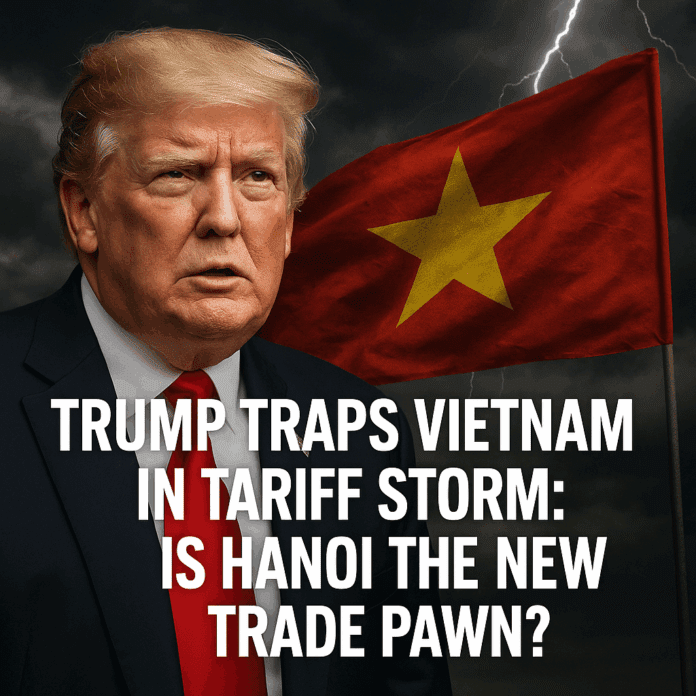Hanoi has found itself in the eye of a political and economic storm. In a surprising move, U.S. President Donald Trump announced a cancellation of tariff deal with Vietnam.
A Sudden Shift in Trade Winds
Under this deal, the U.S. will impose a 20% tariff on Vietnamese exports, replacing a previously threatened 46% rate. However, the catch lies in a steeper 40% tariff on goods that are suspected of being “trans-shipped”—products believed to originate in China but rerouted through Vietnam to bypass American restrictions.
The Trump administration has long accused Vietnam of acting as a conduit for Chinese goods, effectively helping China skirt tariffs while maintaining a trade surplus with the U.S. This new agreement, while toning down the initial threats, still puts Vietnam in a tight spot, exposing the country’s vulnerability in the ever-growing rivalry between the world’s two biggest economies.
???? Caught Between Two Superpowers
Vietnam’s dependence on international trade—especially with the U.S.—has grown rapidly in recent years. In 2024, Vietnam’s trade surplus with the United States reached a staggering $123 billion. With its economy tightly bound to American demand, Hanoi moved swiftly to appease Washington. Vietnamese officials launched raids against counterfeit goods, pledged to protect American intellectual property, and even considered purchasing U.S.-made F-16 fighter jets, a sharp shift from their historically non-aligned defense policy.
At the same time, Hanoi is deeply intertwined with Chinese manufacturing networks. Its economy has evolved into an assembly hub, where parts produced in China are put together and shipped off to Western markets. These complex supply chains—often involving Chinese-owned factories operating on Vietnamese soil—make it increasingly difficult to draw clear lines between Vietnamese-made goods and those indirectly linked to China.
Vietnam Scrambles to Clean House as America Threatens 46% Tariffs Over Counterfeits
This dual dependency has left Hanoi walking a dangerous tightrope. Aligning too closely with the U.S. could provoke economic retaliation from China, while failing to address American trade concerns risks damaging its most profitable export relationship.
???? The Deal Beneath the Headlines
While the optics of the tariff deal suggest a diplomatic win for both sides, deeper analysis reveals long-term pressure points. Trump’s 40% tariff on “trans-shipped” goods directly targets what the U.S. sees as Vietnam’s hidden role in aiding China’s economic strategy. However, identifying such goods is no easy task. Supply chains often stretch across multiple countries, making it difficult to determine the true origin of components in a final product. Trade negotiators and customs officers will likely face months of disputes and documentation reviews, slowing down trade and increasing the cost of compliance for Vietnamese exporters.
On the surface, Vietnam’s pledge to remove all tariffs on U.S. imports and to consider expanding purchases of American products may seem like a diplomatic offering. But these gestures represent only a small dent in the overall trade imbalance. While Vietnam’s government ministries might start driving American SUVs, it won’t come close to offsetting the massive U.S. trade deficit.
Moreover, Vietnam’s agreement is politically timed. The Communist Party of Vietnam is gearing up for its five-yearly Congress, where the country’s top leadership is reviewed and reassigned. Keeping the economy strong and exports stable will be key to any leader’s reappointment, and this deal may help avoid short-term disruptions—though at the cost of long-term strategic leverage.
???? Is Hanoi Becoming a Pawn in Global Trade?
This new agreement paints a worrying picture for Hanoi. Once considered a neutral trading hub, it now finds itself increasingly drawn into the U.S.-China economic conflict. Trump’s tariff moves are more than just financial penalties—they are geopolitical signals meant to force countries like Vietnam to choose sides.
US Slaps 20% Tariff on Vietnam Imports as Trump Announces New Deal
China remains Vietnam’s largest source of raw materials, while the U.S. remains its most lucrative market. Both powers expect loyalty. For Hanoi, remaining neutral is no longer an option. By conceding to Trump’s tariffs and agreeing to inspect its own exports, Vietnam has signaled a tilt toward Washington, even if it still publicly denies any shift in its foreign policy orientation.
The deal also undermines Vietnam’s strategic autonomy. The country may have hoped to rise as a key middle power by leveraging its trade relationships with both the East and the West. But now, it looks more like a bridge under siege, caught between competing powers and unable to chart an independent course.
???? The Ripple Effects Ahead
The effects of this deal may stretch far beyond Vietnam’s borders. Other Southeast Asian countries that serve as assembly hubs—such as Malaysia, Thailand, and Indonesia—are watching closely. If Washington begins cracking down on trans-shipment practices more aggressively, many export-reliant nations could be next.
Meanwhile, China’s response will be key. Will Beijing retaliate economically against Hanoi for cooperating with the Washington? Or will it quietly continue investing in Vietnam’s industrial infrastructure, using it as a backdoor to Western markets?
For now, Vietnam stands exposed. The deal may have bought it a temporary reprieve from steep tariffs, but it has also placed the country under an international microscope. Every container, every supply chain, every cross-border transaction will now face intense scrutiny.
In Trump’s trade war 2.0, no country can hide in the middle anymore. And as this latest move shows, Vietnam might just be the first of many nations forced to choose sides—or pay the price.
